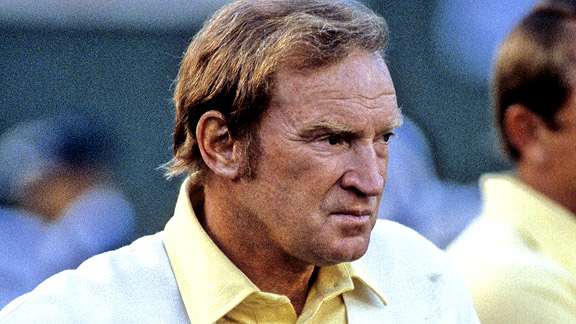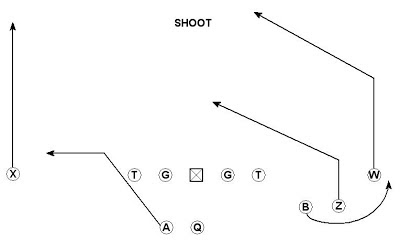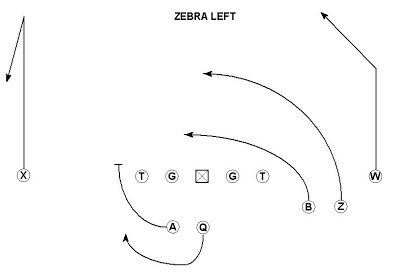 |
| Hmm...Five Wide huh??? |
So we learned from our previous post that the Five Wide Offense contains basically four formations and offers up ten route concepts when it comes to the passing game. The first thing I want to discuss is how these ten route concepts transfer from formation to formation. The example I'm going to use was our favorite concept, known as Shoot.
Here we see Shoot run from the Thunder formation. The W runs a Post, while Z has a slant, and B runs the swing. On the weak side, A runs a shoot route, and X runs the takeoff. Now, the illustrations below show how this route translates into the other formations.
 |
| Shoot from Hurricane |
 |
| Shoot from Storm |
 |
| Shoot from Tornado |
As you can see the routes adapt quite easily. What puts the defense in a bind is the fact that who may be covering said routes via the alignment they start in. Maybe a team has their middle linebacker (MLB) in man coverage on the RB when in 1 back. Well, Shoot from Hurricane or Storm might benefit you because of match up issues with your A or B being a better athlete than your opponent's MLB. Another thing to look at is how the swing route translates into a bubble for the B when he moves out of the backfield. This is very good against man-to-man coverage as the Slant and the Post routes act like pick routes and can easily free up the B on the Bubble.
You can also tag routes with any other route you want to make any combination you want. For instance say you can tell the flat player is taking a really flat angle to come under the Z on Shoot out of the Tornado formation. One way to combat this is to simple go Tornado Shoot B Wheel. Now the B runs a wheel route, and defeats the poor angle of the defender trying to come under the slant route.
Sprintout Package
The routes in the FWO, plus the ability to tag routes makes sprintout an easy concept. Our OC at the time would simply tag a directional call to the concept (ie Hamburger right) and this would tell what side we were sprinting to. Our sprintout rules were as follows:
- The side the call is going to is live, these players run the normal concept routes.
- The side away from the call is dead, the rules are as follows when running routes on the backside of sprintout:
- If only 1 receiver on weak side run shallow drag (in front of LB's).
- If 2 receivers on weak side, then inside receiver runs shallow drag and outside receiver runs deep drag (in front of safeties).
- If 3 receivers on weak side then inside receiver runs shallow drag, middle receiver runs deep drag and outside receiver will run a post route.
- For players in the backfield all routes are dead, you are blocking. Blocking rules are as follows:
- If only 1 player in backfield, and ball is coming to your side, block 1st threat to show outside the PST.
- If only 1 player in the backfield and ball is going away from you, Flop motion will be tagged. QB will flop you over to call side, then execute assignment #1.
- If 2 players in the backfield, then player to call side will block, and player away from call side is treated as the inside receiver and will run the shallow drag.
Let's see how some of these concepts translated to the sprintout game. Here's three examples of running sprintout out of the 2x2 formation Hurricane:
How does this translate to the 3x1 formation of Storm?
The adding of tags simply gives you another way to attack the defense and create even more route combinations.
The one formation we did not sprint out of, was Tornado. With no RB in to block, we felt no advantage by sprinting out of the empty formation. One thing we did a lot of was to sprint to the weak side of our Storm formation (3x1) because a lot of times you got single coverage on that backside single receiver. Remember from the first post, the X is your best WR, so him in a one-on-one scenario is a good thing. Add a mobile QB to the mix, and now the defense can no longer overload the trips side of the formation.
Pass Protection
Pass protection was pretty simple in this offense. There were two basic schemes, big-on-big (BOB) for all drop back passing and turn back for sprintout passes. The last season I was there, the OC switched to zone reach for the sprintout passing, but you get the idea, there were only two schemes our players had to learn.
Having five receivers out in the route meant that you had to have hot routes built in. The OL would handle the down four and the Mike (against odd fronts they declared who the down four were and the Mike with calls, but I never knew them). The remaining six players were all declared by the receivers. The A and B generally had the OLB's while the Z took any overhang to his side while the X and W looked for corner blitzes. The rule our OC had on hot routes was to simply turn around and call for the ball. Now we didn't always do so good with picking up hot receivers, and we had a pretty good screen game to handle teams that wanted to go blitz-happy on us. Another thing the OC could do is add a "Stay" call to any play call and this meant that whoever was in the backfield was to stay in and help block.
 |
| Hot reads |
Now I know what you are saying "That's it???" and you're right, but those were the two basic schemes. We did have a double read tag for odd fronts, but that was later in my tenure, and to be honest if I tried to explain it, I wouldn't do it much justice. Remember, this post is basically from memory, and reading a playbook I stole over ten years ago!
Drawbacks and Disadvantages to the FWO
Here were some things I never cared for about the FWO, again, these are just my opinion, so take them with a grain of salt.
- No good "power" run game. I've know some teams that adopted this style have added a backup QB similar to Tim Tebow or the "Belldozer", but that adds a bit more the teaching style and really changes the landscape of the offense. 75 percent of the run game was some sort of zone scheme, which doesn't always lend itself to be too "powerful" on the three yard line.
- Pass protection was sketchy at times. Good teams we faced that ran a lot of zone blitz stuff really threw us off. Odd front teams, especially the 3-3 and the 3-4 (we saw a lot of 3-4 teams back then, only 1 3-3 team), really could get after us and make our OL's life miserable. Even with the "Stay" call added in, because we spent so much time working on catching the football and timing, our A's and B's never really were that good in pass protection (remember, these guys were basically WR's , NOT RB's).
- Relying on a high school QB just never sat well with me. Our second QB was terrified when it came to throwing the football down the field. He would leave wide open receivers and take off and run, because he was confident in his ability to do so. He was being asked to make reads that were too much on him. Now this isn't really a system complaint, but I was felt if there was a way to tag who we wanted him to throw the ball too, that would be so much better for those QB's who needed a little "help".
- When the offense is off, be ready to have a long night, especially defensively. We were a big enough school that I only had two, players on defense that also played offense. Thank goodness, because we got in some games where my guys were on the field A LOT. The lack of a true running game, did not allow us to run the clock and we had several three-and-outs that didn't burn much more than a minute off the game clock. This factor alone is one reason I would never recommend this to a coach that has a lot of two-way players on his team.
- Having OL that work an innate amount on pass protection was extremely detrimental to our run game. The sled we had at that school was bought the same season I got on campus. In the four years I spent there, I saw the OL hit that thing maybe ten times. Run blocking took up maybe ten percent of the practice time, and it showed. Much like flexbone, wing-t and single wing OL have trouble with pass protection, the same could be said of the FWO and run blocking. Our guys were finesse guys who were decent at pass protection, but weak when it came to knocking our opponents back and creating a new line of scrimmage (LOS).
These are just some of my concerns about the offense. I will say, I like the way the offense is organized and packaged, but my love pretty much ends there. Anyway, I hope this has been informative and helpful and as usual, email me if you have any questions.
Duece

















Tidak ada komentar:
Posting Komentar